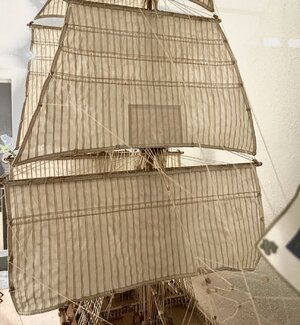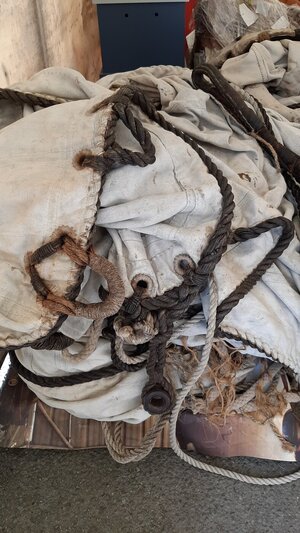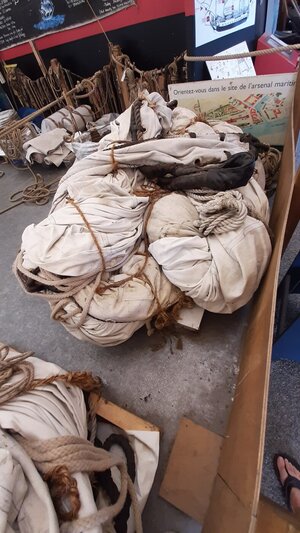Hi Peter. Indeed it is very difficult to make sails in this scale on a sewing machine. As you wrote, the most important is the threat tension. In most of the machines it is adjustable. I made these sails myself on my admirals machine for almost 40 years ago and then the tensions support was already on those machines:Making sails
Hi guys,
Thank you all for following and for all the positive messages. I have been studying on the running rigging and it's not that easy to figure it out. I need more time to really understand the way the rigging works. In the mean time I have to take on another hurdle, making the sails. So I started with simply draw the design of the sails on a piece of paper. The picture below shows the sail of the main mast. It's the biggest of the 3 sails this ship has.


Next step is to make them out of a piece of cloth. Luckily I found some very fine woven cloth in England and ordered some. Cloth found and can be taken off the list.

Next is a sewing machine. I found one in the attic of our home. My Admiral have one, but can't handle the machine.
I have to learn how to operate this "thing"..... I know now much more of threat tension, bobbins, needles, straight stitches, cross stitches......the things I always dreamt of wanting to learn.....
Anyway....after filling the swear jar a couple of times, I start to try it out with the sail of the Mizzenmast. It's the smallest of the three. First step is to draw all the lines on the cloth. All these lines need to be stitches with a straigt stitch. Never.....NEVER start with a very fine, thin and delicate woven cloth. It's one of the most difficult cloths to work with. I don't have the luxury that sails were made of jeans or something....


This was my first run on this type of cloth. Made some test runs on different types of cloth so I learned how to operate this hellish machine....
After this I didn't make pictures, but made the seams separate from the main body of the sail. I made it so that the seam is visible from both sides of the sail.
Then I aged the sail with diluted bitumen. The sail I've made does not make it on te ship and still is a learning piece. The needle that's in the machine is actually to thick and so I have troubles keeping the line straight when sewing the seams on the body of the sail. So I'll go experiment with a much thinner needle.

Until the next update with hopefully 3 finished and hopefully better finished sails.
regards,
Peter

All with double lines. So, it is possible. And perhaps turn your fabric a quarter. The direction of the woven lines is important (schering&inslag).
Good luck and hope to see your results soon.
Regards, Peter
























